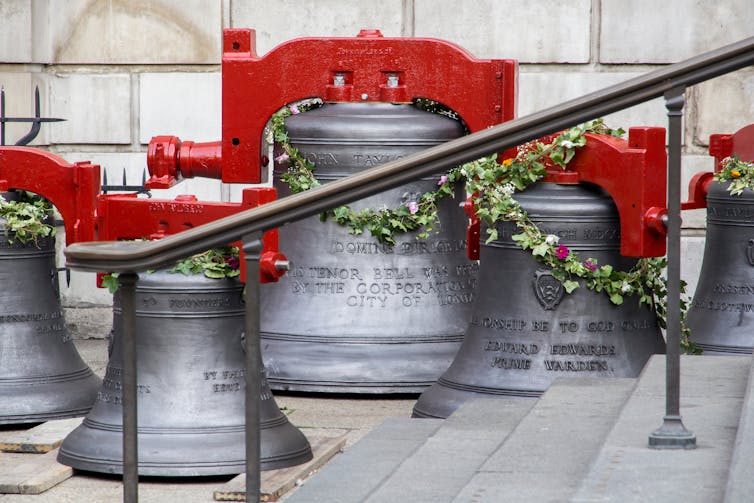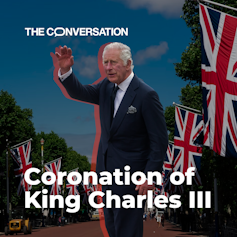Ahead of King Charles’s coronation on May 6 2023, there have been reports of a national shortage of bellringers. The UK counts 38,000 churches. The hope is that each will “ring for the king”, as the Central Council of Church Bell Ringers has labelled its appeal to get more people involved.
Since at least the 16th century, foreign visitors to Britain’s shores have remarked on the ubiquity of its bellringing. Georg Friedrich Händel is credited with labelling the country a “ringing isle”.
These centuries-old bells still sound from church towers today. Children still sing songs telling of their music. Oranges and Lemons famously takes its singers on a tour of London churches:
Oranges and lemons, Say the bells of St. Clement’s.
You owe me five farthings, Say the bells of St. Martin’s.
When will you pay me? Say the bells at Old Bailey.
When I grow rich, Say the bells at Shoreditch.
When will that be? Say the bells of Stepney.
I do not know, Says the great bell at Bow.


This piece is part of our coverage of King Charles III’s coronation. The first coronation of a British monarch since 1953 comes at a time of reckoning for the monarchy, the royal family and the Commonwealth. For more royal analysis, revisit our coverage of Queen Elizabeth II’s Platinum jubilee, and her death in September 2022.
Church bells have left their mark more widely on English culture specifically. Pubs named The Bell or The Ring o’ Bells are found across the country. Bells are routinely pictured on Christmas and wedding cards.
As a musicologist, I have long been interested in the history of communal music-making, including popular ringing and singing for the monarchy. I am a campanologist myself, too, founding and directing our university handbell choir.
The meanings of church bells
Common across Europe since the early middle ages, bells summoned the faithful to worship. They also marked the stages of life from baptism, to weddings, to passing bells for the dying.
Inscriptions on individual bells often gave them names and told their stories. One on a Cambridgeshire bell, dating from 1607 says: “Of all the bells in Benet, I am the best. And yet for my casting, the parish paid the least.”
Sometimes these messages asked the bells to praise God or to carry the prayers of the faithful to heaven. People believed they had the power to dispel thunder and drive away the plague or even devils.
Although hung in church towers, the significance of bells was not merely religious. Bells were aural markers of communities. The traditional definition of a cockney is someone who lives within earshot of the bells of St Mary le Bow, on Cheapside in London.
As some of the loudest noises in the historic soundscape (before the noise pollution of traffic), bells also had a practical function in signalling dangers such as fires, unrest, or invasion.
Even when the Reformation called the theology of bellringing into question, ringing was so deeply embedded in English communities that such practices were reinterpreted rather than suppressed.
Recreational ringing
What really made English bellringing distinctive, however, was the enthusiasm, from around 1600, for a new kind of ringing. Until this point, ringing used simple tolling bells or what ringers call “rounds” (repeated descending scales of tuned bells).
Technological advances in the late 16th century saw bells mounted on fully rotating wheels (as opposed to half wheels with more limited motion). This gave ringers greater control over the timing and enabled the development of what is called “change ringing”, with increasingly complex, predetermined tone patterns. Known as “methods”, these come with charmingly esoteric names such as Cambridge Surprise Major:
or Reverse Canterbury Doubles:
As a result, recreational ringing began to take off. In the 17th century, visitors to England reported hearing bellringing late into the evening by groups of young men often coming straight from drinking in the alehouse. They rang for exercise and for fun. They’d even make wagers as to who could ring the longest, the loudest, or in the best fashion.
The 18th century saw the development of handbell ringing. Initially used by tower bellringers seeking to practise in warmer and more congenial surroundings, ringing well-known tunes on handbells soon became popular. At the height of its popularity in the late 19th century, large handbell ringing competitions were held at Belle Vue in Manchester, with community teams vying to defeat their neighbours.
Royal ringing
Royal coronations, weddings and baptisms had long prompted local celebratory ringing, but during the reign of Elizabeth I many parishes started to ring yearly to mark what they called her “Crownation” day (actually her accession day) on November 17.
Beginning in parishes near London, the trend soon spread across the country and persisted under Elizabeth’s successors, James VI of Scotland (AKA James I of England) and Charles I, the first two Stuart kings. It was subsequently revived after the Commonwealth. Significant political victories such as the defeat of the Armada in 1588 or the failure of the Gunpowder plot in 1605 were also marked by ringing.
Such royal connections continue today. There are several methods named for Queen Elizabeth II: the Queen Elizabeth II delight major, or platinum jubilee surprise minor.
In June 2022, bells large and small rang across the UK to celebrate the Queen’s platinum jubilee. And when Queen Elizabeth died in September 2022, bells fully muffled with leather patches chimed at Westminster Abbey and in churches far beyond – either for 96 minutes or 96 times–to mark each year of her life.
The coronation of Charles III is an opportunity for people to continue this long tradition. Find out about ringing groups in a local tower. If lighter bells or tune-ringing appeal, look up your local handbell team.
I have found it to be a fun way to connect with people of all ages and walks of life. A workout for mind and body, ringing takes practice, but the collective results are rewarding. You are making an audible contribution to your local community and the soundscape of your city.
Katherine Butler is a member of the Handbell Ringers of Great Britain and services on their Education Committee.
This article was originally published on The Conversation. Read the original article.







